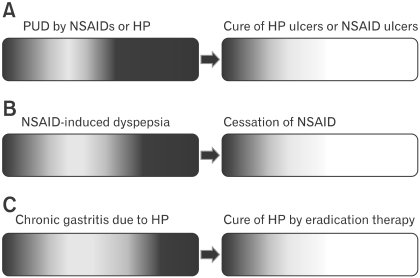Figure 2.
Concept of coexistence of functional disorder with organic diseases. Dyspepstic subjects caused by specific organic causes are shown as graded dark area in the bar representing the population. Patients with severe symptoms are depicted darker in the right side of the bars. Unexplained persistent dyspeptic symptoms may be unraveled only after removal of the causative diseases or drugs. In peptic ulcer diseases (A), for example, a proportion of patients with dyspeptic symptoms may represnt the majority. In contrast, the proportion of symptomatic patients may be smaller in non-steroidal anti-inflammatory drug users (B) and in subjects with chronic gastritis (C). After curing the diseases or stopping the drugs responsible for the symptoms, some subjects may still continue to be symptomatic (indicated as a light grey part of the bars on the right side panels). This group of subjects may be considered as having functional dyspepsia. In this concept, organic diseases and functional diseases are not mutually exclusive and may coexist. PUD, peptic ulcer Diseases; NSAID, non-steroidal anti-inflammatory drug; HP, Helicobacter pylori.

